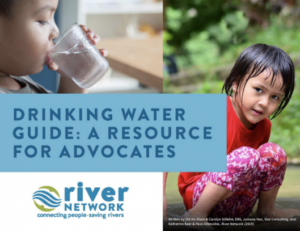River Network’s Drinking Water Guide is a first step in galvanizing a national network of advocates for safe, clean, affordable, and sustainable drinking water and drinking water systems. Supported by the C.S. Mott Foundation, and guided by a Great Lakes–based Advisory Committee, the Drinking Water Guide provides in-depth information, resources, and case studies organized into sections that answer these fundamental questions:
- Where does drinking water come from? How can we protect our drinking water?
- What does a drinking water system do?
- How do we ensure water is safe to drink?
- How is drinking water cost calculated? What do water bills pay for?
- How will climate change affect our water? What can we do about it?
- How can we support community advocacy and engagement on drinking water issues?
Because drinking water safety, sustainability, and access are rising concerns for communities across the country, River Network supports groups and individuals advocating for safe, clean, and affordable drinking water. A philosophy of water equity—the idea that all people deserve access to safe, affordable water—grounds this Drinking Water Guide. River Network hopes that the guide will serve as a key resource for groups and individuals working on these issues to better understand, integrate, and elevate issues of equity and justice as part of their drinking water advocacy.
Why River Network Created the Drinking Water Guide
Clean, safe, and affordable drinking water is critical to personal health and the health of our communities and economy. River Network believes that everyone should have access to drinking water at a cost that does not interfere with other essentials, such as food, health care, housing, transportation, and education.
Challenges to drinking water are varied across U.S. communities and include threats from aging infrastructure, active and legacy pollution, climate change, mismanagement, dysfunctional regulatory framework, attacks on federal safeguards, and a shortage of funding to address these problems. Water suppliers continue to invest billions of dollars annually, mostly at the local level, to keep our water safe to drink; and yet water crises continue.
Many households face affordability challenges. Food and Water Watch estimates that, in 2016, 15 million people in the U.S. experienced a water shutoff. Cities with higher rates of poverty and unemployment had the highest number of homes with water shutoffs. Meanwhile, water utilities struggle to fund maintenance and replacement of aging pipes. Drinking water may not be as secure as generations of Americans have come to expect.
The media has spotlighted drinking water crises around the country—notably in Toledo, Ohio; Charleston, West Virginia; and Flint and Detroit, Michigan. In fact, these are harbingers of more wide-spread issues. Such drinking water crises point to general vulnerabilities of our drinking water systems and contamination threats from lead, nutrient runoff, per- and polyfluoroalkyl substances (PFAS), and chemical spills. In places such as California’s Central Valley, dry wells and rising costs make drinking water access and affordability an issue for many families who have their water shut off when they can no longer afford to pay water bills.
Approximately two-thirds of our drinking water comes from streams, rivers, and other surface waters, and the great majority of infrastructure investment is made at the local level. Drinking water issues are critical focuses for local community and water groups. River Network supports and connects groups working on drinking water issues as part of our focus on Safe and Affordable Drinking Water as outlined in our current Strategic Plan.

